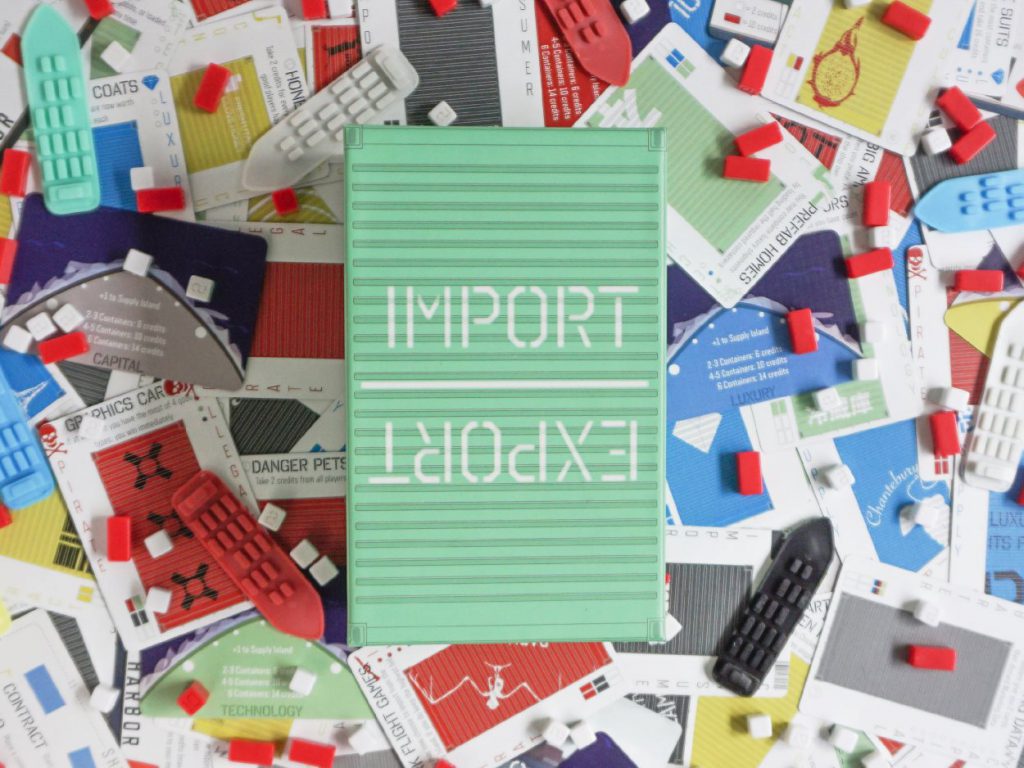Import/Export (2017) – First impressions

Freight and haulage, truly two of the most exciting things known to man. Hark at the speed of my monolithic ocean liners, their horizon besmirching silhouettes heralding the arrival of low-cost consumer goods and mid-priced Chinese electricals. Surely, your pulse is racing right now, the many popular culture associations with shipping and logistics pulling at the strings of your heart?
Or not.
In case you couldn’t tell, I’m not in love with the theme of this game, pick up and deliver, the niche where this setting is normally deployed, being my most loathed type of game. Prejudice fully disclosed, I now feel fit to share my opinion on this hawt new title, fresh from the docks.
Opening the clever little package to play with five players, my first impressions were as follows:
1) My, that’s a lot of cards
2) Why do my boat cards look vaguely like sharks?
3) Where are my one currency units? Why on God’s good Earth have you provided me with massively overproduced twos & tens, but no ones!?!
A quick fight with the rules manual and we’re good to get started. We play a few test hands, where we each take turns performing the various actions for little or no gain, understanding initially escaping us. After two rounds of pulling levers like trapped pigeons in Skinner Box, for the most part we understand what we’re doing. Or think we do.
We play the first game out to conclusion, this only having been floated as something to warm up, and the owner asks, “shall we play again?”.
No-one says “no”. A fine omen indeed, as No-one is a notorious sod, always being contrary about new games which I typically end up liking.
(That was a word joke – or a pun if you so prefer)
Smooth sailing in store for this game perhaps? Let us find out, as after that evening’s play, my Captains Log is abrim with thoughts and impressions.
Firstly, fundamentally this is separated at birth from Glory to Rome & Mottainai. Carl Chudyk must be spinning circles in his… chair (?) right now, as the physical finagling you do with your ‘dashboard’ (or helm, if you will) puts you in exactly the same state of mind.
Work compression cards go on the left, end game scoring cards on the right, power cards on the bottom, things you’re working on towards the top. Rules reminders printed in the centre, in case you fall asleep, wake up and forget where you are. So far, so familiar.
Play a card for action(s), which your opponents may follow, or draw up. Again, nothing mind-blowing here.
However, the actions you take are, in my opinion, way more interesting than many of this game’s contemporaries. Let’s go into some of them:
•Contract – Define a container set that one of your two boats is going to carry. A contract consists of container type, container count and privilege you will receive for completing it. A boat can engage in multiple contracts at the same time, with the only practical limit being that taking any more than 6 containers in a single voyage is less efficient. However, be mindful that you are able to honour the ‘tier’ requirements of a selected contract
* More detail on tiers in the footer, for the more minutiae minded among you
•Load – The most basic action really, where you take cards from your hand which match the colour of a contract to which you’ve committed and load the attendant ship. You can load one card per load action you are entitled to, unsurprisingly
•Pirate – Take a card from the departed ships, releasing them to their owners for new contracts once more, or ‘The Island’, starving Leonardo DiCaprio of his Robot Cats. Rob one card per action, loading it onto your ship or spitefully discarding it into the drink (discard pile)
•Supply – Take a card from the island to the left side of your play mat, improving future action efficiency somewhat, or dump a single card from your hand for four Sea Bucks, the official currency of the oceans
•Import – The most delicious of actions in this game in my opinion! The lead player nominates a ship at sea, declaring an auction to pick two cards from its hull. Everyone who played/followed the action can submit a blind bid for the cards, the owner of the ship selected receiving 2 sea bucks, be it from the winner’s bid or the bank, the remainder of the bid being given to the exchequer. The lead player repeats ship nominations until all Import actions are spent, winning a bid utilising your action. Each won pair of cards can either be locked into improving action efficiency (one card limit per auction) or into endgame majorities scoring & goods specialisation
The reader should note: if a ship’s contracts become fulfilled via Piracy or Loading, then the vessel automatically sails and you get to claim the privilege benefit. The ship won’t become available for new contracts again however until it is stripped of its cargo by yourself or your competitors.
The combination of this myriad of reasonable simple actions creates a very engaging experience. The way the card floor is built and harvested is very dynamic and tactical, each player functionally ‘owning’ a proportion of it, indirectly benefiting from cards being taken from their section. However, sometimes you just *need* Lindsay’s blue cards, even though it’s going to return her ship to dock – what are you going to do? Cut of your bow to spite your hull?
Once you add a wealth of unique cards to the mix, each contributing unique abilities and benefits, you’re left with a highly tactical, dynamic economy game with an engine building element that competes very well in its class.
The increased player count helps lift this title above its peers for me too. It’s a mixed blessing, as it takes longer to get back to your turn but there are more opportunities to follow and sometimes multiple people following can have unexpected consequences, especially in combination with the import (auction) action. In effect, it feels like everyone’s turn is your turn. The flip side of this is if someone goes away for a wee over the side of the ship, as you do, you’re all going to have to wait for them to come back, even ‘off turn’, as you won’t know if they want to follow any played action. Someone getting disengaged and staring at their phone will slow this game down, a lot.
As an honest sailor, I can’t lie to you: After Mottainai, I wasn’t the biggest fan of the Glory To Rome system. I found the terminology obtuse and hard to remember, and the theme incredibly hard to relate to meaning the actions didn’t ‘hook’ for me as well as they might otherwise do. For whatever reason, I found this one a lot easier to pick up and more enjoyable to boot. It could be the inclusion of bidding, a mechanic I adore. Maybe it’s the general aesthetic of this title, the robust fonts and bright colours ticking boxes for me. I certainly think having a stake in the floor, beyond racing others to pick up from it, is a real step up. So, I’m surprised to say that I really enjoyed this one, even though…
<whisper> It’s a three-node pick up and deliver game in disguise and I hate those, remember? </whisper>
There’s a fly in the ointment however. A dolphin in my tuna. An Ahab in my whale…
The price is quite high. $40 plus shipping for what amounts to a couple of decks of cards and some over-engineered currency tokens is a bit rich for my blood. $85 for the all-singing, all-dancing Captain’s edition, with its 3D printed ships (cute as they are, they add very little to play) seems outright ludicrous.
We played the base game and it was very varied and deep. As such, I think I’d struggle to justify the extra $45 for the alternative island and expanded catalogue of container cards (including mixed contracts). However, I’d still covet it, to have a ‘complete package’ (oo-err). That said, I guess you have to ask what your price *anchor* is? If you were planning to spend silly money on Glory To Rome, maybe give this one a try (if you can find a copy) to see if it fills the same niche for you, as $85 is less than $285.
After looking at my navigation charts, I give this a first impression score of 6.5 robot cat filled containers out of 10. I’d be pushing it up to nearer 8 if the price wasn’t so blummin’ high, and I can’t help but think those silly currency tokens that I don’t really appreciate are part of the reason the RRP is what it is. I’ll be bothering my mate to play it every chance I can get, but I’m yet to feel I want to dump my financial cargo on this little container of joy.
I hope you found this useful. Bon voyage & may your packages arrive un-dinged!
* Tier Levels – in the brine detail:
Tier requirements dictate that you meet a target specialisation value of between 0 to 3 for a given container via one of two means.
You can invest in extra contract action capability, slotting the yellow cards into your Import area, which increases your specialisation for all classes of goods, but granting you nothing towards end-game scoring.
Alternatively, you can also count cards of the colour matching the desired contract stored in your goods area, which also happen to double up for end-game majority scoring. This approach is less flexible but can pay off later, as those majority awards are not insubstantial.
A card in either bay contributes one point or ‘tier’ towards the target requirement, higher tier cards offering greater rewards. Two approaches for the same objective with various pros and cons, a plankton-sized example of the depth available to players in this system.
The more you know.

